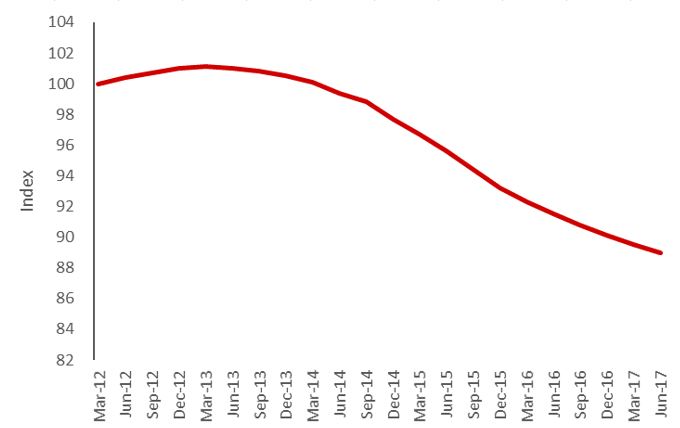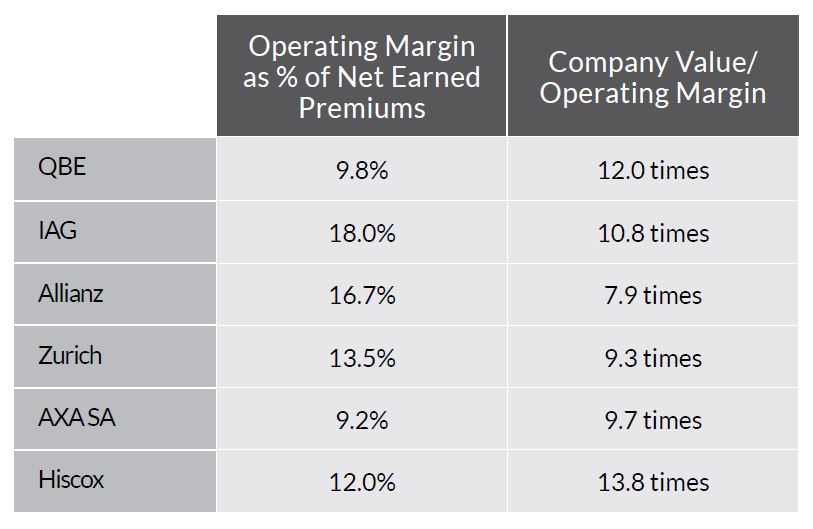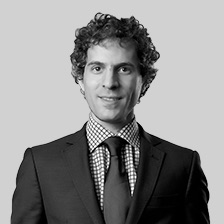Embattled insurer QBE has been the largest beneficiary of the portfolios’ investment dollar over the past quarter. Analyst Justin Koonin discusses the rationale for our investment in this extract from the latest Quarterly Commentary.
 Sharemarket returns have been modest over the recent quarter. The same is true for our portfolios.
Sharemarket returns have been modest over the recent quarter. The same is true for our portfolios.
Our largest exposure remains to energy shares that stand to benefit greatly from the recent gains in energy prices. Nevertheless, a number of company-specific concerns have resulted in some of our investments significantly underperforming their global counterparts. This is particularly true for our largest investment, Woodside Petroleum, which we continue to believe remains very attractively priced relative to the broader sharemarket.
We have written extensively about our energy exposure in the past, so we won’t bore our readers any more than we already have (certainly not on the energy topic anyway). Instead, this report will focus on QBE Insurance Group, the largest beneficiary of our investment dollar over the past quarter (refer to Graph 1).
Justin Koonin discusses the rationale for our investment below, but before jumping into all things QBE, a primer on the insurance market might be helpful.
Graph 1: Portfolio holdings in QBE Insurance Group compared with the share price

Source: Allan Gray. The Allan Gray Australia Equity Strategy includes the Allan Gray Australia Equity Fund and institutional mandates that share the same investment strategy.
How do insurers make money?
Insurers receive premiums in return for underwriting various risks. They make their money in two ways.
- If they are good underwriters, the premiums they earn will more than cover the cost of the claims made against them – this is called underwriting profit. Insurers calculate the sum of the claims cost, commission cost, and expense cost, all divided by the total of the premiums they have earned, which is called the combined operating ratio (COR). A COR of 100% indicates a break-even underwriting result. A COR of less than 100% indicates an underwriting profit. There is certainly no guarantee of underwriting profit; in some years, insurers actually make an underwriting loss.
- Investment returns. Premiums are paid to insurers in advance of claims being paid out, sometimes by many years (this pool of funds is often referred to as a ‘float’). Prudential regulators also require insurers to maintain substantial amounts of shareholder capital that, together with the float, is invested in various asset classes with differing risk profiles and time horizons.
Despite the plethora of confusing jargon for which this industry is notorious, the basic fundamentals which drive value are the same as for any other company. The most important of these is the level of earnings a company can sustainably achieve. For insurers, this is the sum of their underwriting profit and the returns on their investments.
QBE Insurance – Dr Justin Koonin
 QBE Insurance Group Limited (QBE) is Australia’s largest global insurer. It provides insurance services in Australia, New Zealand, North America, Europe, Latin America, and the Asia Pacific region.
QBE Insurance Group Limited (QBE) is Australia’s largest global insurer. It provides insurance services in Australia, New Zealand, North America, Europe, Latin America, and the Asia Pacific region.
The company operates a diverse and somewhat complex network of insurance lines, spanning commercial and domestic property, motor, agriculture, public liability, workers’ compensation and more. The three main divisions – Australia and New Zealand, North America and Europe – are roughly of equal size. In Australia most of QBE’s premiums come from commercial and domestic property insurance. North America also insures a significant amount of property, but has a large crop insurance business as well, while Europe is notable for its maritime, liability, and professional indemnity work.
It is a large and complicated entity. In fact, the scope of the business and the nature of insurance make it quite hard for investors to understand the business completely and we find it equally hard. Sometimes the response of the market to this uncertainty creates buying opportunities.
Why has QBE’s price plummeted?
QBE’s share price has plummeted from a high of $35 in 2008, a time when QBE was growing rapidly through literally dozens of acquisitions made by former CEO Frank O’Halloran, to around $10 today. This spectacular fall was principally due to two factors:
- Many of its acquisitions turned out to be poor and QBE was writing off large swathes of unprofitable business. The past few years have been a sort of insurance purgatory, as the then new CEO John Neal streamlined the business. Every time it looked like things were righting themselves, another issue emerged and investors have grown increasingly weary.
- In what could be described as a perfect storm, the insurance cycle turned down in 2012. Insurance premium rate increases have been modest or negative since then. This despite the probability of an insurance event occurring not changing over that time and the cost of these insured events often increasing. This is best illustrated in Graph 2, which shows the Marsh Global Insurance Market Index, a benchmark of global commercial insurance renewal rates representing the world’s major insurance markets. The graph shows insurance premium rates in 2017 being roughly 10% below those that prevailed in 2012. This has created a significant headwind for QBE’s earnings.
Graph 2: Global insurance premiums have fallen

Source: Marsh, Global Insurance Market Index – Q2 2017
There is reason to be optimistic though. It is our view that the bulk of the heavy lifting has been done and that the business is better positioned today than at any time in the past five years. Also, while we cannot accurately predict the turning in the insurance cycle, it is quite possible that the future is much better than the recent past, as discussed later.
How much should QBE earn?
QBE generates about US$12 billion per annum in insurance premiums. Its underwriting result is targeted to be 4-5% per annum (in fact, a little higher than this in the medium term, but better to be conservative). If achieved, this will generate about US$500m in underwriting profit per annum. In addition to underwriting earnings, QBE has an investment portfolio asset base of US$25b that is mainly invested in short-dated fixed income investments. Assuming a 3% return on this portfolio is sustainable, these assets should generate a further US$750m in annual returns.
Combined, QBE could reasonably be expected to earn US$1.25b per annum in operating earnings before interest and tax – though this term is not standard terminology for insurers. This is an operating margin of roughly 10% of net earned premiums, a figure we consider undemanding considering QBE’s historical margins and those of the insurance industry as a whole (see Table 1).
QBE trades at 11 times these earnings. Not only is this well below the levels that the overall sharemarket trades at, there are reasons to believe that future earnings may be better than we have forecast. As already discussed, the insurance cycle has resulted in downward pressure on QBE’s insurance premiums and therefore its earnings. QBE is also dealing with a number of self-inflicted operational issues that we do not believe are permanent in nature. Once addressed, it might turn out that our assessment of the likely level of future earnings is too low. Investment returns on offer are also historically depressed and at some stage these may also improve.
It is unlikely that all of QBE’s headwinds will abate at the same time and some tend to work against others. Nevertheless, an expectation that QBE’s future earnings should improve from today’s levels is hardly grandiose; compared with other insurers, QBE is materially under earning. Table 1 shows the current operating margins of a number of household insurance companies and close peers of QBE. Most of them are significantly more profitable than QBE.
Table 1: QBE is a relative under earner, profits could improve from here

Source: Factset; all numbers represent June 2017 half-year results
What could go wrong?
One risk we see in QBE, which is worth noting, is its exposure to a housing downturn through its lenders mortgage insurance (LMI) business. LMI is a small part of the business, but it plays quite a significant role in the profitability of the Australia and New Zealand business. The business is reinsured to a certain extent, but a major (40-50%) drop in house prices, coupled with unemployment rates in double digits, will be bad news. We have done a lot of work to try and quantify what these losses could look like, and are comfortable that QBE could sustain them, far more so than a bank, for example, would sustain its exposure.
It is also possible that we have overestimated management’s ability to restructure the complex beast that QBE is (noting that QBE will have another new CEO, Pat Regan, in 2018), or that events outside management control (such as an enormous catastrophe which exceeds QBE’s reinsurance limits) conspire against the company. However, investment is a game of probabilities, and we see our best opportunities, like now with QBE, precisely when expectations are low.
You can read the full Quarterly Commentary here.
Dr Justin Koonin has a Bachelor of Science with Honours and a Doctor of Philosophy in Mathematics from the University of Sydney and is a Graduate of the Australian Institute of Company Directors.


